1 Welcome Email Isn't Enough. Here's Why You Need A Welcome Series (with Examples).
Welcome emails are the fastest way to build trust and turn your newest subscribers into engaged customers. But one welcome email isn't enough. Here's why you need a welcome series.

Written by Lauren Hall
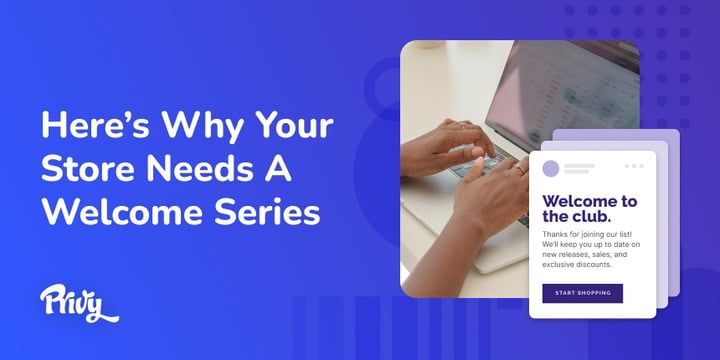
Welcome emails are the fastest way to build trust and turn your newest subscribers into engaged customers.
But one welcome email isn't enough.
That’s where a welcome series comes in.
From building stronger relationships with your subscribers, to creating more opportunities to drive revenue, there are a ton of benefits to having a multi-part welcome series for your Shopify store.
The best part? There are so many different ways to build a successful welcome series from the ground up. And if you’re not sure where to start, here are 8 ideas (with examples) to inspire you.
Get our best content on ecommerce marketing in your inbox 2 times a week
The benefits of a welcome series vs. a single welcome email
There are a ton of brands out there that will send a welcome email, but don’t follow up with any other communication until it’s too late…
Their subscribers have already forgotten who they are or why they signed up for the list in the first place. So they’ll either unsubscribe or completely ignore future messages. Not ideal.
Ultimately, the goal of your welcome series is to nurture the newest members of your list into engaged subscribers and eventually, loyal customers.
Here are 5 reasons you should expand your welcome email into a full welcome series:
1. Build stronger relationships
A welcome series with multiple emails can help you build a stronger foundation with your subscribers. Rather than relying on one email to set the tone for your entire relationship, you can spread out your messaging and focus on one topic at a time.
Think about it. You wouldn’t dump everything on a potential partner on the first date. You have to win them over little by little. The same is true with your brand.
Then, once your series has ended and these newcomers start receiving your regular newsletters, they’re primed and ready to hear from you. They’re not left wondering, “What is this brand? I don’t remember joining this list…”
If you nail your welcome series, they’ll know exactly who you are, how your products can help them, and look forward to supporting you. It’s really hard to make that happen with a single email.
2. Put a name and face to your brand
Don’t forget people want to support people. Even though there are many small brands selling on Amazon, it’s hard not to picture Jeff Bezos any time you’re shopping. You’re certainly not imagining the founders behind the brands.
That’s where you have a huge advantage. You can lean into the fact that you’re a real person and help your subscribers put a face (and memorable story) to your business.
Send your emails from a real person (ex: Lauren from Privy) to keep hammering the point home. You can even update the photo that shows up in your subscribers’ inboxes to include a photo of you, the founder.
Of course you can do this with a single email, but with a series, you have the chance to really focus on your founding story and introduce yourself and your team. It’s really hard to squeeze that into a welcome email if you have other topics you want to cover, like highlighting your best-selling products, for example.
3. Build trust with your audience
Because a welcome series is spread out over a number of days or weeks, you’re able to really build trust.
By spacing out your messaging, you can share everything from your founding story to your sustainability practices and helpful content before you ever ask for a sale.
Unlike a single welcome email, you’re really able to focus on the main messages you want to get across from the very beginning without overwhelming your readers.
And because the beginning of your relationship is so critical for building trust, your welcome series is the best place to start. Then by the time you actually do ask them to take action and make a purchase, they’re much more likely to take that step.
4. Be more thoughtful about your CTAs
With a single welcome email, it can be easy to try to cram in as many calls to action (CTAs) as possible.
But when you break that single email into a series, you can be much more thoughtful about what you want to share and how you want to share it.
Rather than muddying your message with multiple sections, you can take the time to focus on one thing at a time. One email for your story, one email to share your brand values, and another to highlight some of your most popular products, for example.
When you’re thoughtful about your messaging, you’re much more likely to keep your subscribers engaged, which ultimately, is the goal. You want them to want to hear from you.
5. More emails = more chances to convert subscribers into buyers
Repetition is key. You know the saying that people have to hear things 7 times before they actually remember it?
Well the same is true for your email marketing. The more you’re able to get in front of your newest subscribers, the more likely they are to remember who you are.
Plus, with small reminders about your products throughout your welcome series, you increase your chances of landing a sale. Because just like it’ll take time to build trust, chances are your audience isn’t buying from you right away. You have to earn that.
And multime emails in your welcome series means you have a much better chance of getting those subscribers to convert into customers.
Still not convinced? Here are examples and ideas you can use for your own welcome series to knock it out of the park and kick off the relationship with the newest members of your list in the best possible way.
8 topics to inspire your welcome series (with examples!)
First things first. There’s no specific winning formula when it comes to crafting the perfect welcome series. But before you panic, that’s actually good news.
It means you can share whatever makes sense for your brand. Whatever messaging you think will resonate with your audience.
Here are 8 ideas you can steal for topics to cover in your welcome series. Just remember you don’t want to overwhelm your newest subscribers. So don’t try to cram everything you can possibly think of into your emails. Break it into a series of easy-to-read messages that will build trust and, ultimately, loyalty.
And remember: you do NOT need to cover each of these topics in your welcome series, this is meant to inspire you so you can take what works for your store and leave the rest behind.
Share your brand's mission and values
The perfect way to kick off a new relationship is to reinforce the mission and values of your business.
Because just like your audience wants to support a real person, they also want to support people who have similar priorities.
So if you’re focused on sustainability or you give back, your welcome series is a great place to highlight that.
Take a look at this example from Lola:
They call out the fact that they use natural ingredients and that women are behind the brand. As a feminine products business, this is especially important and helps build trust from the very beginning.
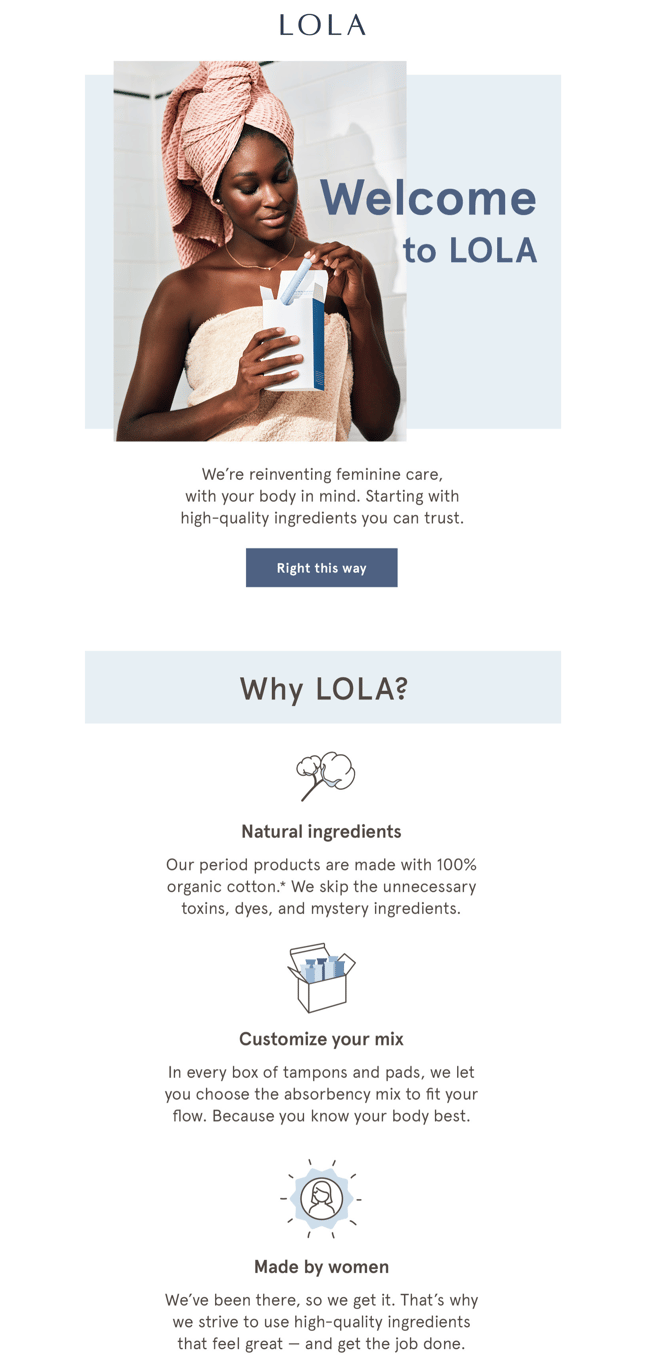
Weave in your brand's founding story
Chances are, you have an “About Us” page on your site where you share your brand’s founding story and why you got started in the first place. But that doesn’t necessarily mean your audience has seen it!
When you tell your story, the chances your newest list subscribers remember you as a founder are so much higher.
Here’s a great example from Muddy Bites:
This email is an incredible example of a founding story (I’ve honestly never seen another I love as much as this one).
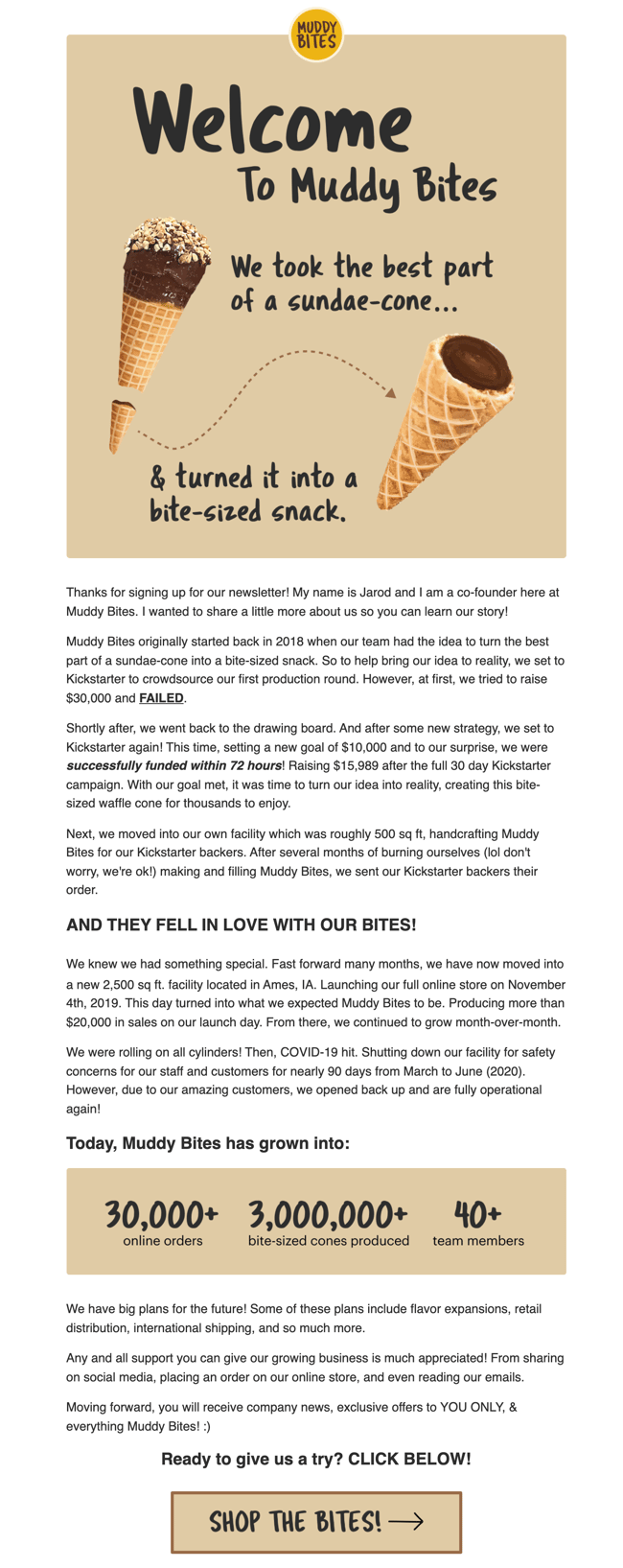
Yes, there’s a CTA at the very bottom of the message that points you back to the product, but the main purpose of this email is to build a connection with the reader.
You find out they weren’t immediately successful but their team persevered and has grown to a team of 40+ plus people and it’s something you remember.
This is the bar you should have for your own welcome email. Very few businesses are going to spend the time making it this good. But if you prioritize it, I promise you’ll stand out in a big way and your readers will remember you.
Highlight your brand's environmental/social impact
How good do you feel buying something from a business you know gives back? The same goes for your customers and prospects.
Which is why highlighting the environmental or social impact your business has from the very beginning is brilliant.
Here’s a great example from Bombas:
In this case, a sock is not just a sock. For every purchase you make, they give back.

This is also the kind of mission-driven business people keep coming back to and tell everyone they know about.
Educate about your core products
Once you’ve taken the time to tell your story, share your mission and values, or highlight your business’ impact, NOW you can start to introduce your products.
But you still want to be careful not to come on too strong. Which is why product education is a great place to start.
Blueland does a great job with that here:
As a highly sustainability-focused business, Blueland leans into the fact that their bottles are reusable and made to last.

If you have educational content like a blog post or video, this is a great place to share it rather than pointing your subscribers directly to a product page. Just keep that in mind when you’re thinking through the messaging you want to share in your welcome series.
Walk through frequently asked questions
Chances are, if one person has a question about your company or products, many others do too. Which is why highlighting your frequently asked questions early on is a great way to both cut down on support-related messages and keep the education going strong.
Here’s a great example from Girlfriend Collective:
By highlighting things like sizing, inseam and process questions, they’re getting ahead of the game and bringing the answers directly to their audience rather than making them do the heavy lifting.

And while you probably don’t want to call out your FAQs at the very beginning of your welcome series, it’s great to fill in later messages with this kind of proactive information.
Encourage a follow on social
Getting your newest subscribers to follow you on your most active social media channels is a natural next step.
Rather than pushing them to look at your products immediately, you can keep adding value and building trust on social.
Take this example from Marea:
It highlights the founder, Monica, her story, and a little about the power of the product, but ultimately, the only ask here is to follow Marea on Instagram, where they can continue learning about the product, brand, and people behind the brand.
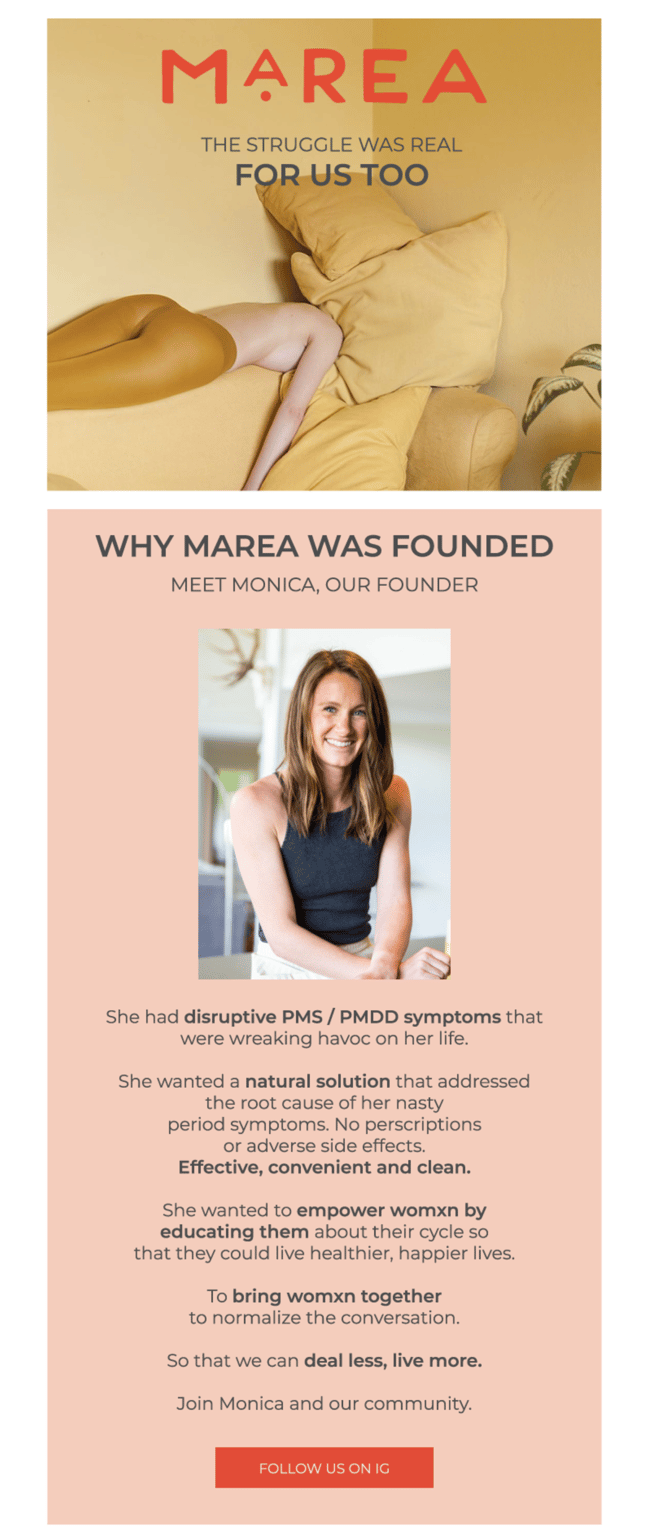
Feature your product guarantee
In the same vein as your frequently asked questions, removing doubt by sharing your product guarantee is an awesome way to bust objections and give your new subscribers confidence in your business and products.
Take a look at this example from Darn Tough:
A lifetime warranty like this is an incredible way to build trust with your newest email subscribers because you’re mitigating the risk.

If something happens to your new socks, you can get a replacement, making the risk of trying something new tiny.
So if you offer any kind of warranty on your products, share it! Make sure your audience knows about it as soon as possible. It might be the exact thing they need to be convinced to give your products a try.
Share helpful content
If you sell a ton of products and often get support questions about which would work best to solve a specific problem, a quiz could be the perfect way to get the newest members of your list started.
On top of sharing her personal story, that’s exactly what the Elix founder does here:
With their health assessment, you share your concerns and it spits out products that can help. Anything you can do to help point people in the right direction is a great place to start with your content.
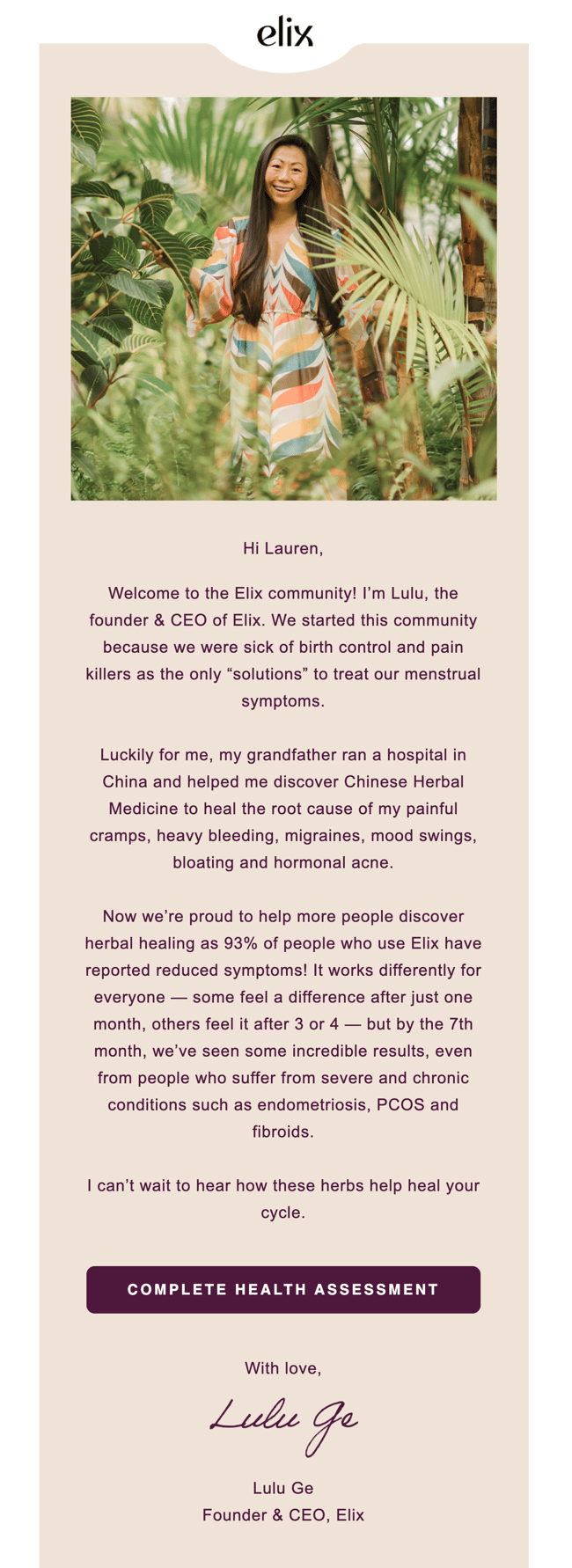
But even if you don’t have something like a quiz for your store, chances are you have some sort of existing content that would be helpful to your audience. And your welcome series is a great place to include it.
When to send the emails in your welcome series
Before you panic and think you need to have a 10-part welcome series, here are best practices you can follow to nail your welcome series without feeling overwhelmed.
First, start with a 3-part series to stay top of mind during your subscribers’ first week on your list.
You can always adjust the number of emails in your series, but starting with 3 gives you space to dedicate each email to a specific topic and build trust at the same time.
So, when should you send your emails?
Welcome Email #1: Send no later than 24 hours after signup when subscribers are expecting to hear from you and still remember you.
*Quick caveat here. Chances are, your subscribers joined your list to receive something like a discount or free shipping. You need to deliver on that promise immediately. With Privy, you can set up an after signup email that will go out immediately after a new subscriber joins your list. Then, you can trigger your welcome series to go out after that. Check out this post for more on the difference between after signup and welcome emails.
Welcome Email #2: send 48 hours after your first email, not too soon after the first email that it might be annoying to subscribers, but soon enough that your brand is still fresh on their minds.
Welcome Email #3: send 5 days after your second email. This will help you strike a balance between consistently reaching out to new subscribers in the first week and being sensitive to how many emails are already in their inbox.
Pro tip: the content of these emails should “flow” and feel like a logical progression from one to the next. So outline the most important topics you want to cover and put them in an order that makes the most sense.
Setting up your welcome series shouldn't be stressful
With Privy, it’s never been easier to get your welcome series up and running. Plus, now that you have a handful of ideas for what to include in your welcome series, you’re off to a solid start.
Just remember that there’s no perfect formula. You have so much freedom to do what works for your brand.
But most businesses aren’t going to take the time to put a series in place. So it’s a huge opportunity for your store to stand out and build strong relationships from the very beginning.
The welcome series is available today as part of Privy’s welcome email feature in our Starter or Growth plans.
Writen by Lauren Hall

Lauren is a Brand Marketing Associate at Privy. She's the brains behind all things content. When she's offline, she's obsessing over her Bernedoodle pup, Monster, and plotting ways to being a full-time Vermonter ASAP.
You may also like to read
Learn how we responsibly build, test, and refine AI models and capabilities to ensure accuracy and domain relevancy.
Privy’s Email Automation Playbook: Ready-to-Use Formulas To Steal (Even If You're Not An Expert)
Want to bring in sales for your store 24/7? Here's what you need to know to activate the 4 most important email automations for your store ASAP.
Every Shopify Store Should Be Sending These 18 Types Of Newsletters (With 245+ Examples From Real Brands)
Consistency is key for building a successful email marketing calendar. But what exactly should you be sending? Here are 245+ examples and 18 types of emails to steal.
How to Create a Stunning Email With Privy: 15+ Design Tips and Best Practices
A well-designed email is key to communicating with your audience, building engagement and trust, and driving sales. Learn these 15+ tips and tricks for creating beautiful and effective emails in Privy.
